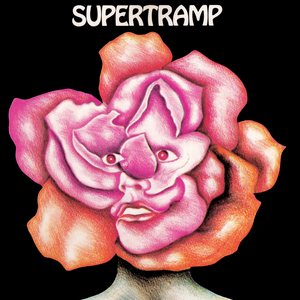 Album title: Supertramp
Artist:
Album title: Supertramp
Artist: Supertramp
Nationality: English
Label: A&M
Chronology: Debut
Grade: B
Previous Experience of this Artist: Big Supertramp fan; have all their albums
The Trollheart Factor: 10
Landmark value: Little really; I feel this and the next album they released went largely unremarked, and it wasn’t until
Crime of the Century, their third album, that they would come to the public notice. Ironically, this would also be the time when they moved mostly away from prog rock and towards more, if you will, prog pop, but more of that later. I believe you could be a Supertramp fan and never have heard this album, which would be a pity as it rewards repeat listenings.
Tracklisting: Surely/It’s a Long Road/ Aubade - And I Am Not Like Other Birds of Prey/Words Unspoken/Maybe I’m a Beggar/Home Again/Nothing to Show/Try Again/Shadow Song/Surely (Reprise)
Comments: Anyone who’s seen the Playlist of Life will know that I reviewed this album in full not once, but twice (quite by accident; forgot I had already written one and only realised after it had been posted duh!) so what more can I say about it? Well, in fairness not everyone may have read that, or I should say those reviews, so I won’t take the easy way out. Let me start by noting that, as I mentioned in the Landmark Value section above, this album (and the one that followed it) bear little to no resemblance to the later ones, such as
Breakfast in America, Even in the Quietest Moments or
Crime of the Century[, with a very soft folk/psych rock direction taken by the fledgling band.
The album is bookended by two versions of the piano ballad “Surely”, a very short one opening the album while a longer version closes it out wonderfully. The first voice we hear is that of Roger Hodgson, one of the founders, and the voice radio listeners would later get used to hearing on hits like “Dreamer”, “It’s Raining Again” and “The Logical Song”. I always thought, whether it was planned or not, the juxtaposition of the two voices - Hodgson’s soft crooning almost feminine voice compared to Rick Davies’ more growling, ragged blues voice - worked really well, and again whether it was deliberate or just coincidence, Davies always tended to take the harder, more mature songs while Hodgson took the lighter, more commercial ones, leading to his being the voice most people would identify as that of Supertramp.
There’s a dark blues feel then to what I suppose you’d have to call the first real track, “It’s a Long Road” with some fine organ from the as-yet-silent Davies, who won’t add any vocals until well into the second side of the album. There’s a fair bit of jamming on this album, and that’s possibly due to the fact that, as stated in (both of my) review(s) Hodgson and Davies were both worried about writing lyrics - the two wrote all the music but the lyrics came from the soon-to-depart guitarist Richard Palmer. Some nice harmonica here too from Davies. The odd title of the third track - “Aubade/And I Am Not Like Other Birds of Prey” - just screams hippy sixties, and indeed the song is a quiet, gentle, reflective piece carried again on organ, soft this time, and “Words Unspoken” is one of my favourites, with a very gentle acoustic line and a sweet vocal from Roger.
Musicians they may be, singers certainly, songwriters (later) absolutely, but here, at least, they were not producers. I can barely hear the vocal (or much else) when “Maybe I’m a Beggar” begins with a sort of Celtic flutey uillean pipes thing going on. It’s very low in the mix. What is? Everything really. Oh, I see it’s a flageolet. Sounds vaguely kinky. Right, now it’s coming more to the fore - not the flogger sorry flageolet but everything, mostly on Palmer’s powerful guitar and Davies’ insistent organ. “Home Again” is barely a minute of acoustic goodness with a soft little vocal before we blast into “Nothing to Show”, where for me the album dips sharply in quality.
I just don’t like the sudden change from what has been, mostly, pastoral folky-ness to a rip-roaring blues freakout, and while it introduces us to the vocals of Rick Davies for the first time, it’s my least favourite track on the album. It’s another of those jams, and to be perfectly and brutally honest, what lyric there is is about as throwaway as it gets. So no, I don’t like it. It’s soon forgotten though as we retreat into the enchanted forest for the beautiful “Shadow Song” as Hodgson puts Davies back in his box and takes over vocals again, then the longest, jammiest track gives us twelve minutes plus of “Try Again”, which isn’t as bad as I remember, not at all. Still not crazy about it though; has that kind of “Echoes” feel - the middle bit, you know? Album closes then as I mentioned on a longer version of “Surely” with a wonderful organ and guitar solo to take us out.
Favourite track(s): Surely/ Aubade- And I Am Not Like Other Birds of Prey/Words Unspoken/Shadow Song/Surely (reprise)
Least favourite track(s): Nothing to Show
Overall impression: In some ways, when I listened to this first, I had a Genesis to Revelation moment, thinking is this the same band? Still, it certainly shows if nothing else the musical talent and vocal talent of the two guys, mostly Hodgson, but like a lot of prog (ish) bands it’s a gentle nudge into the consciousness rather than a kick in the head, or indeed anywhere else.
Personal Rating:  Legacy Rating:
Legacy Rating:  Final Rating:
Final Rating: 



 And where that kind of sappy soft-rock/ambient drivel belongs.
And where that kind of sappy soft-rock/ambient drivel belongs.















:format(jpeg):mode_rgb():quality(90)/discogs-images/R-2835493-1428854238-6576.jpeg.jpg)
:format(jpeg):mode_rgb():quality(40)/discogs-images/R-2030237-1259575888.jpeg.jpg)

 Hybrid Mode
Hybrid Mode